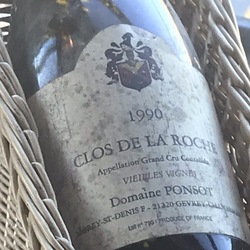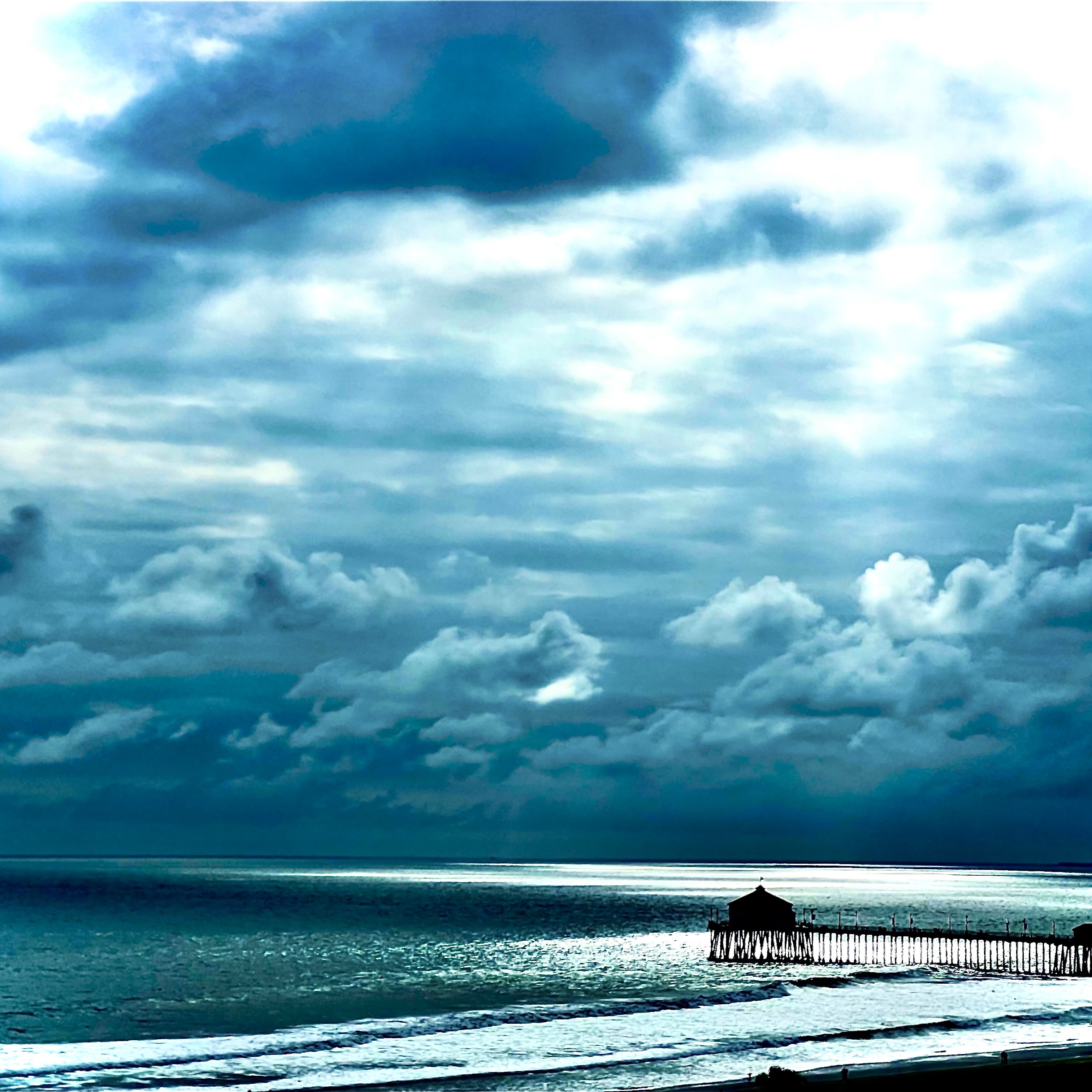Le Vigneron Savoyard
Karim Vionnet
Vin de Kav Chiroubles Gamay 2018
A winegrower that I have been following with passion for several years: Explosive bouquet of fruits and flowers, enhanced with cinnamon notes. A "natural" Beaujolais Gamay, light and crunchy in the first hours after opening. Then the wine unfolds and unfolds again. After 12 hours, the wine is round. The acidity is lively and the tannins are both tight and opulent. It is delicate and full. Wonderful on a home-made marguerita pizza (with arugula).
Un vigneron que je suis depuis quelques années avec passion. Bouquet explosif de fruits et de fleurs, rehaussé de notes cannelées. Un gamay « nature » du Beaujolais, léger et croquant au premières heures après l’ouverture. Puis le vin se déploie et se déploie encore. Après 12h on a un vin rond, ample, l’acidité est vive et les tanins sont à la fois serrés et opulents. C’est fin délicat et ample. Magnifique sur une pizza marguerita home-made (avec de la roquette). — 5 years ago
Clos Canereccia
Corse Red Blend Paysan Vigneron 2016
Red fruit-forward, herbal, tannic. Similar in profile to a Chianti Classico, but a little sweeter. With soy-scallion burgers, Sriracha mayo and roasted Yukon gold potatoes in soy sauce and butter. — 6 years ago
Lulu Vigneron
Yellow Côtes du Jura White Blend 2014
Beautiful expression of an underrated region. Crisp minerals, dry, and moderate acidity. Notes of lemon and chalk. — 7 years ago
Les Chais du Vieux Bourg
Lulu Vigneron Côtes du Jura Pinot Noir Savagnin
Dry and Smokey Pinot. Medium fruits. Pretty for a birthday wine — 8 years ago
Domaine Servin
Les Clos Chablis Grand Cru Chardonnay 2014
Getting prepped to go out for another gem - Boka. Delicious start to our evening. Wine not mature yet but 14s rock and this one really shines. Vigneron Domaine Servin — 8 years ago
Emmanuel Rouget
Echézeaux Grand Cru Pinot Noir 1990
Tasted blind. Reddish tawny and young looking. Intense nose. Notes of raspberry, rhubarb, camphor, mocha, Asian spice and dark soil. Rich and intense in the mouth. We’re told this was given lots of air – which led guesses to be red burg more in the late 90s or 00’s. The reveal was exciting as none of us have had a bottle from this vigneron before. Super high quality juice, still on it’s upward climb. This juice will be around, giving pleasure to those that have it, for another decade or two and will undoubtedly improve with more age. — 5 years ago
Vince Vigneron
BGB LB17 Red Blend 2017
Perfect glou glou. Just complex enough to make it interesting but still incredibly easy to take down a bottle quickly. — 6 years ago
José Gil Vigneron
La Cóncova Rioja Tempranillo Viura 2016
Full bodied, Earthy, violets in nose, velvety texture, liquorice/anise finish — 7 years ago
Vince Vigneron
Rockaille Billy Gamay
Volcanic gamay — 7 years ago
Rene Rostaing
Ampodium Côte-Rôtie Syrah 2010
2010 was a very good vintage in Rhône. Rostaing is a well know producer with people that know and drink Northern Rhône wines, not so much with others that do not. The Ampodium is the entry level into Rene & Pierre Rostaing wines. It is a blend of 13 vineyards in Northern Rhône. They are simply one of the very best producers in the region. I spent an afternoon with Rene & his son Pierre tasting in the their cellar and in their La Landonne vineyard as shown in the photos. The 2010 is drinking beautifully with many good years ahead. On the nose; ripe & slightly stewed/baked fruits of; blackberries, dark cherries, strawberries, creamy raspberries, stewed plum, black raspberries, cherries, steeped fruit tea, dry crushed rocks, iron pan, some white & black pepper, bacon fat, grilled savory meats, pork, black licorice, black cherry cola, decayed & fresh red florals with violets. The body is round and medium full. The tannins round, still a little chewy & around 55% resolved. The length, texture, tension and balance are in near perfect harmony. The fruits are; round, ruby & ripe; slightly stewed/baked fruits of; blackberries, dark cherries, strawberries, creamy raspberries, stewed plum, black raspberries & cherries. Steeped fruit tea, dry crushed rocks, chalky minerals, iron pan, coffee grounds, spice, some baking spices w/hints of vanilla, white & black pepper, drying blood, dry herbs/bay leaf, dry stems, moderate levels of bacon fat & pork, grilled savory meats, black licorice, black cherry cola, decayed & fresh red florals with fresh violets for days. The acidly is round and dripping. The long finish is plush, velvety delicious and lasts & lasts. In good vintages, I would put this in blind with the best of of the best new world wines from any vintage that many love; SQN, Booker, Saxum, Alban, Cayuse, Horsepower etc.. I’d bet most of you would pick it over these producers that cost much more $$$. It’s simply one of the best pound for pound wines/producers for this varietal. Especially, for the $$$. Wow, what a wine for the $. $55 upon release. Photos of; Winemaker Pierre Rostaing and our group in their La Landonne vineyard, the small sign that barely identifies their Estate, an example of the Quartz mineral that runs throughout their La Landonne vineyard and the view back onto the river from the top of the very steep La Landonne Vineyard. Producer notes and history...Rene Rostaing produced their first wine in 1971. However, it took almost three decades before wine became a full time occupation for Rene Rostaing. Domaine Rene Rostaing came about through marriage. The wife of Rene Rostaing was the daughter of the famed Cote Rotie grower, Albert Dervieux, and the niece of Marius Gentaz-Dervieux who gave Christine the vineyard land that became the Northern Rhone estate for Rene Rostaing. Through inheritance from Albert Dervieux Thaize (his father-in-law) who retired in 1990, and from Marius Gentaz Dervieux, his uncle, Rene Rostaing expanded his holdings, giving him some of the best terroir in Cote Rotie. The new vineyard land was basically 3 small parcels in the La Landonne, Cote Brune and Vialliere lieux-dits. This initial expansion from his initial tiny parcel, allowed Rene Rostaing to change careers and become a full time vigneron. Since 2007, the estate has managed by Pierre Rostaing, (son) of Rene Rostaing. Currently Rene Rostaing owns 7.5 hectares of vines that is spread out among 20 different parcels located in 14 locations. Perhaps the most celebrated vines of Rene Rostaing are the 1.6 hectares of vines they own in the La Landonne vineyard (photo). On La Landonne, the vines are more than 60 years old. Some vines are even close to 100 years of age! Those are his largest holdings. The smallest vineyards of Rene Rostaing are located on Cote Blonde. Rene Rostaing also has vines planted in; Fonjean, La Vialliere, Le Plomb, Bouchare, Leyat, La Roche and La Tupin. Their oldest vines are more than 70 years old and are used for Rene Rostaing Cote Blonde. The majority of those plantings are on the steep hillsides with mica, schist and rocky soils. 25% of those vines are closer to the bottom of the slopes and on the flats. Rene Rostaing remains a traditional Cote Rotie producer who is not among the last to harvest. His wines are aged using very little new, French oak barrels. On average, Rene Rostaing Cote Rotie are aged in about 10% new French oak barrels. Rene Rostaing produces 4 different Cote Rotie wines. Rene Rostaing Ampodium, which was previously known as Rostaing Cuvee Classique, is a blend of 13 sections of different vineyards, but it does not include their best holdings on La Landonne or Cote Blonde. The fruit for Rene Rostaing Ampodium has at least 40% or more of the stems removed and run between 12-13.5% abv. The wine is usually made from 100% Syrah and is aged in an average of 15% to 25% new, French oak barrels. The amount of new oak can be less, depending on the character of the vintage. About 1,750 cases are produced each year. The wine is no longer called Cuvee Classique, the name was changed to Rene Rostaing Ampodium with the 2009 vintage. Rene Rostaing La Landonne comes from a terroir consisting of sands with iron oxide and traces of quartz. This wine is always produced from 100% Syrah. The grapes are partially destemmed, with about 10% to 20% of the stems removed, depending on the vintage. There are vintages when no destemming takes place. The remainder of the grapes are whole bunch fermented in stainless steel vats. Rene Rostaing is not a believer of using too much new oak for the aging, which on average uses 10% new, French oak barrels and the remainder of the harvest is aged in demi-muids (600 liter) and French oak barrels. This wine is like most wines from La Landonne, masculine and meaty in character, requiring at least a decade to soften and develop. On average, Rene Rostaing La Landonne produces less than 600 cases depending on what the vintage delivers. Rene Rostaing Cote Blonde is perhaps his best. It’s produced from a blend of 95% Syrah and 5% Viognier. The grapes are co-fermented. The vineyards is planted in the region call Arzel. Arzel is a poor, mineral laden soil with deposits of Silex and Mica on a steep hillside. The vines are more than 50 years of age. The grapes are partially destemmed…35% to 50% of the stems are removed. The remainder of the grapes are whole bunch fermented in stainless steel vats.
The remainder of the harvest is aged in demi-muids. This one is the hardest to find and most collectible of all their wines. In fact, they only produce close to an average of 350 cases of Cote Rotie in most vintages. Rene Rostaing Cote Brune made its debut with the 2013 vintage. The vines were once part of the holdings of Marius Gentaz, which eventually passed to Rene Rostaing. Rostaing replanted those vines in 2000. Made from 100% Syrah. — 8 years ago
Vince Vigneron
Tournoël Riot Pinot Noir
Fantastic wine! A lot of punch! From auvergne where Cedric and Fab are from. Rare and expensive ish — 5 years ago
Fabien Jouves
Artisan Vigneron You Fuck My Wine 2019
yes just yes. explosion of sour cherry goodness — 5 years ago
François Secondé
Vigneron Passionne Brut Grand Cru Rosé Champagne Blend
Strawberry jam on a biscuit. Absolutely delicious. — 5 years ago
Vigneron a Mareuil sur Cher
Les Sucettes a l'Aunis Pineau d'Aunis
initially smelt of burnt rubber but opens up into an airy woodsy place with hints of sweetness. hints of jam, pepper, and tart blackberries. super light finish. — 7 years ago
Vince Vigneron
Les Crosses Blanc White Blend
Grilled lemons, green herbs, acid, mineral, savory finish... lovely sunshine juice. — 7 years ago
Pattes Loup (Thomas Pico)
Vent d'Ange Chablis Chardonnay 2015
Assez gras pour un Chablis, j’ai beaucoup aimé, très belle découverte de ce très bon vigneron — 7 years ago
Les Chais du Vieux Bourg
Lulu Vigneron Côtes du Jura Poulsard 2015
Red fruit with bright acidity and earth/mineral notes — 8 years ago
















Anna-Claire Hayden
Not too sweet, easy and bright. — 5 years ago